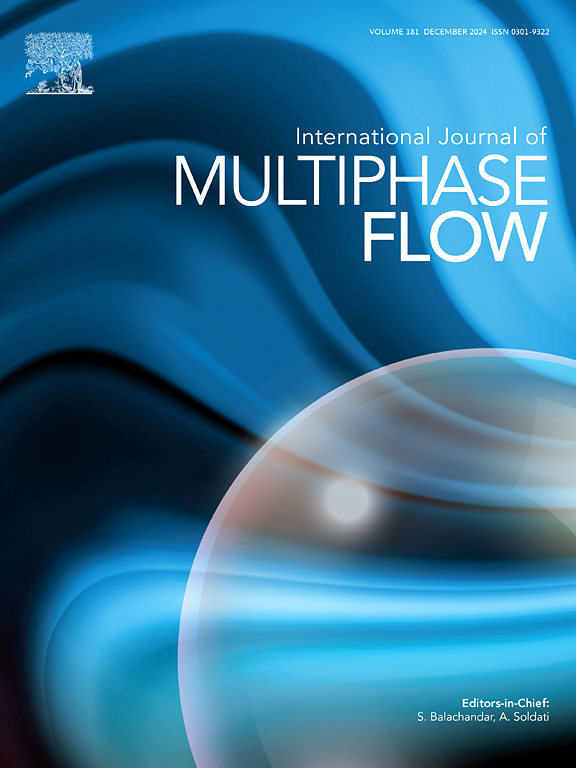Visualized experimental study of steam condensation on a vertical tube with non-condensable gas (air) under free convection
IF 3.6
2区 工程技术
Q1 MECHANICS
International Journal of Multiphase Flow
Pub Date : 2025-04-08
DOI:10.1016/j.ijmultiphaseflow.2025.105248
引用次数: 0
Abstract
The presence of non-condensable gas (NCG) significantly reduces the condensation heat transfer coefficient (HTC) during steam condensation. However, the impact of condensate modes and dynamic behavior on NCG during steam condensation remains poorly understood. Moreover, prior research on the effect of wall subcooling on HTC has conflicting results. This study addresses these gaps through a visualized experimental investigation of steam condensation on the outer surface of a vertical tube under free convection with NCG (air). The experiment covered a range of parameters, including air mass fraction (0.08–0.4), wall subcooling (4–23 K), and system pressure (0.1–0.4 MPa). Visualization revealed three distinct condensate modes: film, droplet-film, and droplet-film-stream. At an air mass fraction of 0.08, a steam pressure of 0.15 MPa, and a subcooling of 10.0 K, observations on the tube wall surface revealed four dynamic features: droplet merging, droplet shedding and flushing, droplet dynamic growth, and film flow. At a steam pressure of 0.1 MPa and a subcooling of 8.0 K, a 1 % increase in air mass fraction resulted in an average decrease of 136.9 W/(m² K) in the condensation HTC below 30 % air mass fraction, and 42.9 W/(m² K) above 30 %. In particular, the HTC exhibited an increasing trend followed by a decrease with increasing wall subcooling. Based on the experimental data, an experimental correlation for the average HTC was developed as a function of air mass fraction, wall subcooling, and system pressure. The correlation accurately predicted 90 % of the experimental data within a 10 % uncertainty range.

自由对流条件下不凝性气体(空气)在垂直管内冷凝蒸汽的可视化实验研究
不凝性气体(NCG)的存在显著降低了蒸汽冷凝过程中的冷凝传热系数(HTC)。然而,在蒸汽冷凝过程中,凝析模式和动态行为对NCG的影响仍然知之甚少。此外,以往关于壁过冷对HTC影响的研究结果相互矛盾。本研究通过与NCG(空气)自由对流下垂直管外表面蒸汽冷凝的可视化实验研究来解决这些差距。实验参数包括空气质量分数(0.08-0.4)、壁面过冷度(4-23 K)、系统压力(0.1-0.4 MPa)。可视化显示了三种不同的冷凝模式:膜,液滴-膜和液滴-膜流。在空气质量分数为0.08、蒸汽压力为0.15 MPa、过冷度为10.0 K时,对管壁表面的观察发现了液滴合并、液滴脱落和冲刷、液滴动态生长和膜流动四个动态特征。当蒸汽压力为0.1 MPa,过冷温度为8.0 K时,空气质量分数每增加1%,在空气质量分数低于30%时,冷凝HTC平均降低136.9 W/(m²K),在空气质量分数高于30%时,冷凝HTC平均降低42.9 W/(m²K)。特别是,随着壁过冷度的增加,HTC呈现先升高后降低的趋势。根据实验数据,建立了平均HTC与空气质量分数、壁面过冷度和系统压力的相关关系。该相关性在10%的不确定度范围内准确地预测了90%的实验数据。
本文章由计算机程序翻译,如有差异,请以英文原文为准。
求助全文
约1分钟内获得全文
求助全文
来源期刊
CiteScore
7.30
自引率
10.50%
发文量
244
审稿时长
4 months
期刊介绍:
The International Journal of Multiphase Flow publishes analytical, numerical and experimental articles of lasting interest. The scope of the journal includes all aspects of mass, momentum and energy exchange phenomena among different phases such as occur in disperse flows, gas–liquid and liquid–liquid flows, flows in porous media, boiling, granular flows and others.
The journal publishes full papers, brief communications and conference announcements.

 求助内容:
求助内容: 应助结果提醒方式:
应助结果提醒方式:


